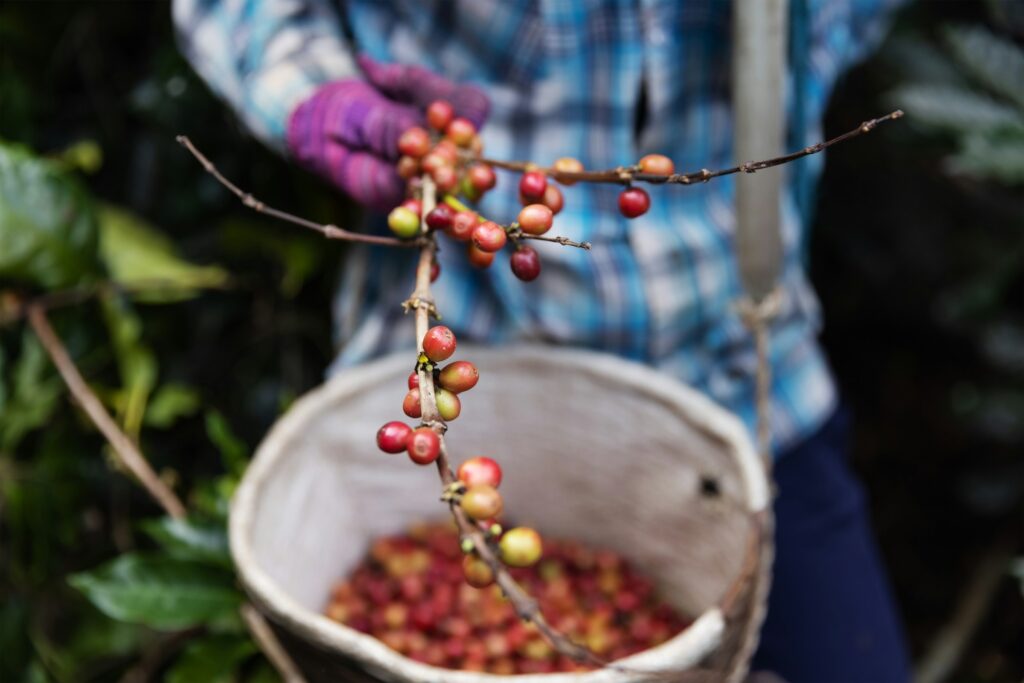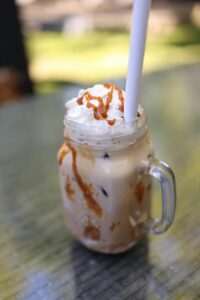Think of coffee like wine—where it grows changes everything. A bean from Ethiopia can taste like berries, while one from Colombia leans toward chocolatey and rich.
That’s the magic of single-origin coffee.
Simply put, it’s coffee sourced from one country, one region, or even a single farm. No blending, no guesswork—just the pure character of that place in your cup.
Why does this matter? Because origin shapes flavor, guarantees quality, and tells a story about the farmers and land behind your brew.
And once you taste it, you’ll never see coffee the same way again!
What Is Single-Origin Coffee?
Single-origin coffee is exactly what it sounds like—beans that come from one specific place rather than being mixed with others.
That place could be an entire country, a particular region within that country, or even a single farm where the beans are grown.
Unlike blends, which are created by mixing beans from multiple origins to achieve balance or consistency, single-origin coffee highlights the unique fingerprint of its environment.
You’ll also see variations like “estate” coffee, which means all beans are from one farm, or “micro-lot,” which refers to an especially small, carefully managed crop.
These labels aren’t just marketing tricks, but they tell you how focused the source of your coffee really is.
By narrowing down the origin, you get a clearer sense of the story in your cup: the soil, altitude, and climate that shaped it, the farmer who tended it, and the traditions behind it.
It’s like getting the unedited version of coffee—raw, distinct, and deeply tied to where it comes from.
The Flavor Factor
The flavor of single-origin coffee is shaped by its terroir, like the soil, climate, and altitude where the beans are grown.
Just like grapes, coffee plants soak up the character of their environment, and that character shows up in every sip.
Beans grown high in the mountains often taste brighter and more acidic, while those from lower altitudes lean smoother and heavier.
The soil matters too—volcanic soil can give a clean, crisp edge, while rich loam may add depth and sweetness.
That’s why an Ethiopian coffee might burst with fruity, almost wine-like notes, while a Colombian coffee often delivers a smooth, chocolatey body that feels like dessert in a cup.
These differences aren’t subtle either; they’re what make single-origin coffee stand out from blends. Blends aim for balance and familiarity, but single-origin puts its quirks on display.
Quality & Freshness
One of the biggest perks of single-origin coffee is traceability because you know exactly where your beans came from, which makes it easier to ensure quality from farm to cup.
If something tastes off, roasters can trace it back to a specific region or harvest instead of playing a guessing game with mixed beans.
That level of transparency usually means better care during farming, processing, and roasting, because the reputation of a single farm or region is on the line.
Another detail worth noting is seasonality: coffee is an agricultural product, not a factory good, so certain origins are only available at certain times of year.
This means your favorite Ethiopian or Guatemalan might taste best during its harvest window, making single-origin a bit like fruit—always fresher when it’s in season.
Roasting ties into this as well; lighter roasts are often chosen for single-origin beans because they highlight the natural flavor notes that make them unique, while darker roasts tend to mute those distinctions in favor of boldness and body.
The end result? A cup that feels alive, fresh, and honest—like you’re tasting the region itself, not just “coffee” in a generic sense.
Transparency & Ethics
Single-origin coffee doesn’t just taste different, but it feels different, because you know exactly where it came from.
That traceability matters; it connects your morning brew to real farmers and communities instead of leaving it as a mystery blend on the shelf.
Many single-origin coffees are sold under fair trade or direct trade models, which means farmers get paid more fairly for their work and roasters build long-term relationships instead of chasing the cheapest deal.
This kind of trade not only supports families but also encourages better farming practices, since quality and sustainability become just as valuable as volume.
On top of that, single-origin often goes hand in hand with eco-friendly choices—shade-grown crops that protect biodiversity, water-efficient processing methods, or farms that focus on reducing chemical use.
So every time you sip a cup of single-origin, you’re not only tasting the unique flavor of a region but you’re casting a vote for more ethical wages, better farming conditions, and a healthier planet.
It’s proof that a simple habit, like choosing one bag of beans over another, can ripple out in ways that matter far beyond your kitchen counter.
When to Choose Single-Origin vs. Blends
Single-Origin: For Exploration and Adventure
If you’re the kind of person who likes to try new flavors just for the thrill of it, single-origin coffee is your ticket.
Each bag feels like a little passport stamp—Ethiopia might greet you with blueberries, while Guatemala might pour you a cup full of cocoa and spice.
Because the beans are unblended, every sip is an unfiltered expression of that region’s personality.
These coffees shine when brewed as black coffee, especially with methods like pour-over or AeroPress, where clarity and nuance take center stage.
They’re also the go-to for specialty drinks that celebrate flavor rather than hide it under cream and sugar.
Blends: For Balance and Everyday Comfort
Blends are like comfort food—reliable, steady, and made to please a wide range of palates.
Roasters mix beans from different regions to balance acidity, sweetness, and body, which means you’ll get consistent taste cup after cup.
They’re often crafted with milk-based drinks in mind, like lattes or cappuccinos, where boldness and body need to stand up against dairy.
If you’re someone who wants your morning coffee to taste the same every day without surprises, blends will have your back.
Practical Tips: Choosing What Works for You
Think about how you usually drink your coffee. If you like it black, single-origin will reward you with complexity and surprises worth savoring.
If you’re a latte lover, a well-made blend may be the better match since it’s built for balance.
You don’t have to pick sides, either—keep a blend on hand for your daily fix and a bag of single-origin for when you feel like experimenting.
How to Brew Single-Origin Coffee for Best Results
Brewing Methods That Let the Flavors Shine
Single-origin coffee is all about clarity because you want to taste the unique notes without too much interference. That’s why methods like pour-over, AeroPress, and cold brew are such good choices.
Pour-over gives you a clean, bright cup that highlights fruity or floral flavors. AeroPress offers versatility; you can tweak time and pressure to bring out sweetness or body.
Cold brew, on the other hand, smooths everything out while still preserving those subtle differences between origins.
Grinding and Freshness Matter
Even the best beans can fall flat if they’re ground wrong or left sitting too long.
A medium-fine grind works beautifully for pour-over, while AeroPress allows you to play around with grind size depending on your recipe. Cold brew loves a coarse grind, almost like breadcrumbs.
Whatever method you choose, grinding right before brewing is key because pre-ground coffee loses flavor faster than you can say “stale.”
Store your beans in an airtight container away from light and heat, and you’ll notice the difference in every cup.
Experiment and Enjoy the Ride
The beauty of single-origin coffee is that it invites you to experiment. One day, you might brew a washed Ethiopian as a pour-over and taste citrus notes.
The next day, try the same beans in an AeroPress and suddenly they taste sweeter, almost like honey. There’s no “perfect” way—just different perspectives on the same origin.
Think of it like cooking with fresh produce: the fun is in trying, tweaking, and sometimes stumbling onto a flavor combo you didn’t expect.
The process is just as rewarding as the result, and with single-origin coffee, the journey really is part of the joy.
Common Misconceptions
Myth: Single-Origin Is Always “Better” Than Blends
A lot of people assume single-origin automatically means superior, but that’s not the full story. It’s not about better or worse, but it’s about purpose.
Single-origin is perfect when you want to explore unique flavors or taste the character of a specific region.
Blends, on the other hand, are designed for balance, consistency, and versatility, especially in milk-based drinks.
It’s like comparing a solo singer to a choir; both can be amazing, but they shine in different contexts.
Myth: Single-Origin Is Always Expensive
Another common myth is that single-origin coffee will break the bank. While some rare micro-lots or limited harvests can get pricey, plenty of single-origin coffees are just as affordable as blends.
The price often reflects factors like farming practices, availability, and quality control, not just the label.
Flavor Exploration, Not a Hierarchy
The real point of single-origin isn’t to crown it king of coffee, but to invite curiosity. It’s an opportunity to explore flavors you’d never find in a standard blend and to connect with the story behind your cup.
Single-origin is about discovery, while blends are about reliability. Neither sits on a throne above the other—they just serve different roles.
And when you look at coffee through that lens, your morning brew becomes less about labels and more about enjoying the ride.
Final Words
At the end of the day, origin is the coffee’s identity, and it’s what gives each cup its voice. Single-origin lets you taste that story, while blends smooth it into harmony.
Both have their place, but only one will surprise you with flavors you didn’t see coming.
So here’s the challenge: grab a bag of single-origin and brew it next to your usual blend. Taste them side by side.
Notice the contrast, the quirks, the little details. You might just discover a new favorite, and your morning coffee will never feel the same again!
FAQs
What’s the difference between single-origin and estate coffee?
Single-origin means beans come from one country or region, while estate coffee goes a step further by coming from a single farm or estate. Estate coffee is essentially a very specific type of single-origin.
Is single-origin coffee always lighter roasted?
Not always. Many roasters prefer lighter roasts to highlight the bean’s unique flavors, but single-origin beans can be roasted darker if that’s what suits the coffee or the roaster’s style.
Does single-origin mean higher caffeine?
No. Caffeine levels depend more on the coffee species (Arabica vs. Robusta) and brewing method than whether it’s single-origin or a blend.
Why do some single-origin tastes “weird” compared to blends?
Single-origin beans can taste unusual because they showcase distinct regional flavors without being balanced out by other beans.
What feels “weird” to some drinkers might feel exciting and unique to others.
Can I find affordable single-origin coffee at the grocery store?
Yes. While some single-origin coffees are pricey, plenty of roasters and even grocery brands offer budget-friendly options.
They may not be rare micro-lots, but they still give you a solid taste of what single-origin is all about.



